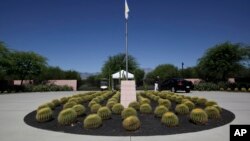With a backdrop of Beijing's growing assertiveness in the disputed South China Sea, President Barack Obama is set next week to host the leaders of the 10 ASEAN members at an estate near Palm Springs, California.
Analysts caution that expectations about the outcome need to be managed.
“This being the last year of President Obama in office, I'm not particular strong on the idea that a great deal of substance can be done,” said Simon Tay, chairman of the Singapore Institute of International Affairs.
The Philippines and Vietnam are among those involved in maritime territorial disputes with China, and increasingly looking to Washington for security assurances. That puts them apart from some of the other ASEAN states, which resist amplifying the rhetoric toward Beijing.
That also could make it difficult for any substantive or groundbreaking proclamation emerging from the meeting in California.
“I don't think the United States is setting out to wreck anything,“ said Hong Kong University international law professor Chin Leng Lim. “But of course the United State has concerns about the South China Sea, about freedom of navigation... and these issues will be put up front at the summit.”
Obama administration officials see ASEAN as a key pillar in America's geo-strategic rebalancing to Asia and the Pacific, as well as a desire to enhance economic ties with the growing region.
"We want to make very clear that the United States is going to be at the table and a part of setting the agenda in the Asia Pacific in the decades to come. In order to do that, we need to be engaging organizations like ASEAN at the highest levels," Deputy National Security adviser Ben Rhodes said this week.
Professor Lim, a specialist on regional trade and development, told VOA, that "We don't have an ASEAN speaking with one voice on several issues of interest. And I think if you accept that, what it means is that the United States and the U.S. agenda for the meeting is effectively and firmly in the driving seat of this summit.”
And much of the current focus in ASEAN is on trade.
Twelve countries signed in Auckland, New Zealand last week the Trans-Pacific Partnership. The trade pact includes four ASEAN members: Brunei, Malaysia, Singapore and Vietnam. Two others, Indonesia and Thailand, are seen as eventual candidates for the TPP.
“If the United States is pushing the TPP and the idea of an ASEAN-United States free trade agreement isn't going to fly, then we really have to look at pragmatically at how the various ASEAN members can be brought into the TPP over time,” said HKU professor Lim.
ASEAN has been negotiating for more than three years with six other countries (Australia, China, India, Japan, South Korea and New Zealand) for another so-called free trade agreement known as the Regional Comprehensive Economic Partnership (RCEP).
“ASEAN is facing a new competitive landscape, with the signing of the TPP and the near conclusion of RCEP negotiations that will bring together 16 countries in Asia,” said Asian Trade Center executive director Deborah Elms in Singapore. “To remain relevant, ASEAN must take regional integration seriously. Without concrete results, globally mobile firms will focus their attention and resources elsewhere.”
ASEAN also launched its own long-planned economic community from the beginning of the year, theoretically creating a single entity for 600 million people. It has little of substance yet, but its proponents express optimism that it will achieve its goal of being a single market and production base, with free flow of services, investments and labor by the year 2020.
The US-ASEAN summit venue, the 80-hectare Sunnylands estate, once the home of a billionaire publisher, was used by President Obama to host Chinese President Xi Jinping in 2013.
“Diplomatically, symbolically, this is putting ASEAN – 10 medium-size and smaller countries – virtually on par on China, which is a great acknowledgment of the distance ASEAN has come since past years,” Tay in Singapore told VOA.
ASEAN members run the political gamut from full democracies to states under one-party Communist rule.
President Obama personally invited all of the ASEAN leaders to Sunnylands when he attended the ASEAN summit three months ago in Malaysia.
The summit participants, besides addressing the key regional security and trade issues, also are expected to discuss climate change and human trafficking.














